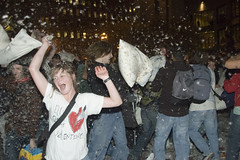Yesterday, Gawker pointed to an interesting article by Bill Wasik, senior editor of Harper’s, who invented the flash mob by his account on May 27, 2003 as a social experiment.
Wasik writes in the March issue of Harper’s:
Wasik says he started the fad by sending himself an e-mail from an anonymous account, which he then forwarded to 60 of his friends and acquaintances, ranging from the early twenties to mid-thirties.
The first “mob” was thwarted by police, but that was when Wasik came up with the idea to give an initial location from which the mob would then be dispatched to the final destination. This worked, with about 200 people showing up in Macy’s, and ultimately became the model for the flash mob.
The Flash Mob became an immensely popular, if not short lived, social epidemic. San Francisco, Minneapolis, Boston and Austin started their own flash mob chapters.
While the tone of Wasik’s article makes him seem transcended above the cast of hundreds that heeded the call of the flash mob, I hope that he counts himself as one of these “hollow hipsters” since he started the movement because he was “bored and therefore disposed toward acts of social-scientific inquiry.”
only thing that Wasik says the flash mobs were trying to accomplish was what he calls “scene art,” or art that is the scene in itself.
Wasik says he has gone public now since he feels his “experiment” is complete with the extension of his idea in last summer’s Fusion Flash Concerts, which were put on by Ford in partnership with Sony last summer. You can read more about that in a post by Howard Rheingold last summer.
I imagine he also went public to sell more magazines and pump up his image. Word-of-mount campaigns can be powerful, but no one like to be manipulated. All I can say is that I am glad I am not one of Wasik's “friends” — if he has any after this.
Wasik’s essay, which appears in the March 2006 Harper's Magazine, will be serialized on this its website over the next several weeks.
